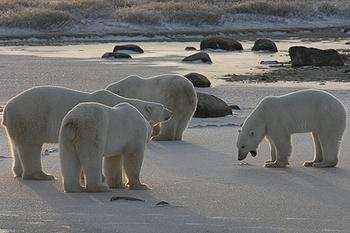保育團體表示,美國環保署無視於美國境内使用農藥所造成的污染,影響瀕危的北極熊和其棲息地,決定在60天內對其提出告訴。

生物多樣性研究中心(Center for Biological Diversity)辯稱,美國本土經環保署核准使用的農藥,透過大氣、海洋、生物等途徑流竄到北極已是不爭的事實。
該中心聲稱,「這些農藥透過食物鏈造成生物放大效應,越靠近源頭藥性濃度越高。因此,位居北極地區食物鏈頂端的終極掠食者--北極熊,往往中毒最深。」
農藥中的污染物與北極熊免疫功能下降、內分泌失調、生殖器官縮小、雌雄同體、初生熊寶寶死亡率增加有連帶關係。
有鑒于生物多樣性研究中心採取的請願和訴訟行動,北極熊終於在2008年5月15日根據瀕危物種法案,被正式列為瀕危物種。儘管如此,環保署仍尚未審查任何農藥的使用對其產生的影響。
所有美國的農藥,必須向環保署註冊後才可以合法使用。而法院也判定環保署,必須審查所有合格的農藥對受瀕危物種法案保護物種的影響。
上週在哥本哈根,世界自然保育聯盟北極熊專家小組于4年來首次會晤面談,並得出結論認為,污染物和氣候變化導致對健康不良的影響,為威脅北極熊生存最嚴重的的兩個因素。
該專家小組此次做出有別以往前幾次會議的結論,認爲保育北極熊最大的挑戰,是北極地區氣候變暖造成的生態變化。
另外,專家小組指出,「北極熊的健康狀態受到持久性污染物的影響。」
與此同時,小組總結道:「氣候變化似乎改變了這類污染物滲入生態系統的途徑。」
專家重新評估了北極19種可辨識,分佈在廣闊相對偏遠地區北極熊亞種的分佈狀況。
他們得出以下結論,19種亞種中,1、3、8個群種分別呈現成長、穩定、下降的情況。至於其餘的7個亞種,限於數據不足而無法對目前的趨勢作出評估。
普遍認為目前全球北極熊總數為2萬至2萬5千隻。然而,科學家們表示,「對於各類不同北極熊亞種數據採集優劣混雜的情況下,意味著其中誤差的空間很大。」
A conservation group says that in 60 days it will sue the U.S. Environmental Protection Agency for failing to consider impacts of contamination resulting from pesticide use in the United States on the threatened polar bear and its Arctic habitat.
The Center for Biological Diversity argues that pesticides approved by the EPA for use in the United States are known to be transported to the Arctic via various atmospheric, oceanic, and biotic pathways.
These pesticides are "biomagnified with each step higher in the food web, reaching some of their greatest concentrations in polar bears, the apex predators of the Arctic," the group contends.
Pesticides and related contaminants have been linked to suppressed immune function, endocrine disruption, shrinkage of reproductive organs, hermaphroditism, and increased cub mortality in polar bears.
The polar bear was formally listed as a threatened species under the Endangered Species Act on May 15, 2008 following a petition and litigation by the Center for Biological Diversity, but the EPA has yet to examine the impacts of any pesticide on the species.
All pesticides in the United States must be registered by the EPA before they can be lawfully used. Courts have held that the agency must examine the impacts of any pesticide it approves on species protected under the Endangered Species Act.
Meeting last week in Copenhagen for the first time in four years, the IUCN Polar Bear Specialist Group concluded that the adverse health impacts from contaminants and climate change are the two most serious threats to polar bear survival.
The Polar Bear Specialist Group renewed the conclusion from previous meetings that the greatest challenge to conservation of polar bears is ecological change in the Arctic resulting from climatic warming.
The Polar Bear Specialist Group noted that "polar bears suffer health effects from persistent pollutants."
At the same time, the Specialist Group concluded, "climate change appears to be altering the pathways by which such pollutants enter ecosystems."
The specialists reevaluated the status of the 19 recognized subpopulations of polar bears distributed over vast and relatively inaccessible areas of the Arctic.
They concluded that one of the 19 subpopulations is currently increasing, three are stable and eight are declining. For the remaining seven subpopulations available data were insufficient to provide an assessment of current trends.
The worldwide total number of polar bears is still thought to be between 20,000 and 25,000. However, the scientists said that the "mixed quality of information on the different subpopulations means there is much room for error in establishing that range."






